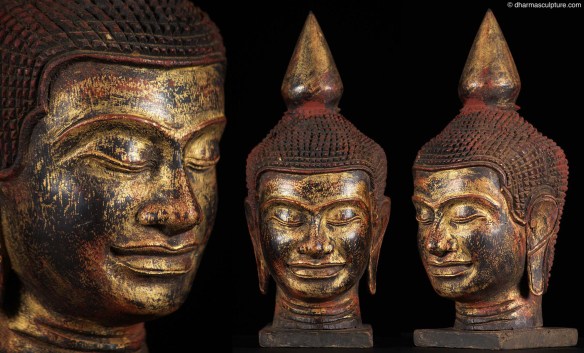
This is lovely rendition of Shakyamuni Buddha! Lord Buddha has a serene expression and a hypnotizing gaze in his eyes.
The Buddha Shakyamuni, at the moment of enlightenment, invoked the earth as witness, as indicated by the fingers of his right hand, which spread downward in bhumisparsha mudra, “the earth touching gesture”. As the Buddhist sutras narrate, the sun and moon stood still, and all the creatures of the world came to offer respect to the Supreme One who had broken through the boundaries of egocentric existence. All Buddhist art celebrates this moment and leads the viewer toward the Buddha’s experience of selfless and unsurpassed enlightenment.
Buddhist art pictures the Buddha in numerous manifestations, but always as a model of human potential, never as a historically identifiable person. All forms of the Buddha, however, are commonly shown seated on a lotus throne (as seen here), a symbol of the mind’s transcendent nature.
“Be a light unto yourself,” Buddha Shakyamuni declared at the end of his life. Become a Buddha, an awakened being, he urged, but never a blind follower of tradition.
This Buddha statue has the distinguishing marks that designate his celestial status, such as the cranial bump (ushnisha) and the conspicuous mark in the middle of his forehead (urna). He wears a distinctive robe elaborately decorated with elegant flowing floral motifs. In the back of the base is the wheel and deer emblem. The Buddhist emblem of a golden eight-spoked wheel flanked by two deer represents the Buddha’s first discourse, which he gave in the Deer Park at Sarnath, near Varanasi. This discourse is known as the ‘first turning of the wheel of dharma’, when the Buddha taught the doctrines of the Four Noble Truths and the Eightfold Noble Path to five Indian mendicants.
As a symbol of the Buddha’s teachings a gilded three-dimensional wheel and deer emblem is traditionally placed at the front of monastery and temple roofs, from here it shines as a crowning symbol of the Buddhadharma. This emblem similarly appears over the four gateways of the divine mandala palace.
There are 2 separate pieces to this statue: the Buddha and its double lotus base. This copper statue is fully gold plated with 24k gold and then hand painted. The face of the Buddha is painted with a 24k gold mixture. The gold is crushed into a powder and then made into a paste. The gold paste is mixed with an organic paint mixture then used to paint the most important part of any Buddha statue; the face.
Like this:
Like Loading...










